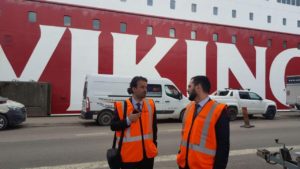Thessaloniki, Greece (PortSEurope) June 28, 2018 – Rail Cargo Logistics Goldair, a joint venture between ÖBB (Austrian Railways) and Goldair, has been inaugurated and will operate the first private train service in Greece. The firsts service connects the port of Thessaloniki with the Sindos commercial and industrial zone.
An objective of Rail Cargo Logistics Goldair is to develop freight transport, previously part of the state monopoly railway business.
The project is aligned with the standards of the EU which calls for the development of the transport sector, including the freight by rail. The project will attract new investment, open thousands of jobs, and shift the cost of transport with multiple benefits to the consumer.
Goldair Executive Vice President, Kallinikos Kallinikos, said, “the launch of the new railway undertaking marks the opening up of the rail transport market and the practical implementation of the Community rules on railway infrastructure management and the activities of railway transport. In this context, OSE, with its upgraded role as Infrastructure Manager, under the guidance of the Ministry of Infrastructure and Transport, supports every development effort that contributes to the country’s exit from the crisis”.
The Minister of Infrastructure and Transport, Christos Spirtzis, speaking at the inauguration, pointed out that in the autumn the double railway line of Athens-Thessaloniki will be completed and we will also have a trip of 3 hours and 20 minutes in the passenger transport. But even more important for freight transport, for the goodwill it gives to ports, this country is the axis. Autumn will also be ready for the electrification line from Thessaloniki to Edomeni. Under the transnational agreements with Bulgaria and the enlargement to be made with Romania, the ports of Northern Greece will be linked to the ports of the Black Sea. And what does this mean for the international transport map and what it means for railway infrastructure and companies operating in our country”.
The company can now claim that it has direct connections to northern European markets and plans to link more Greek ports, as well as other ports in neighbouring countries, such as Constanta, Romania.
Source: PortsEurope





